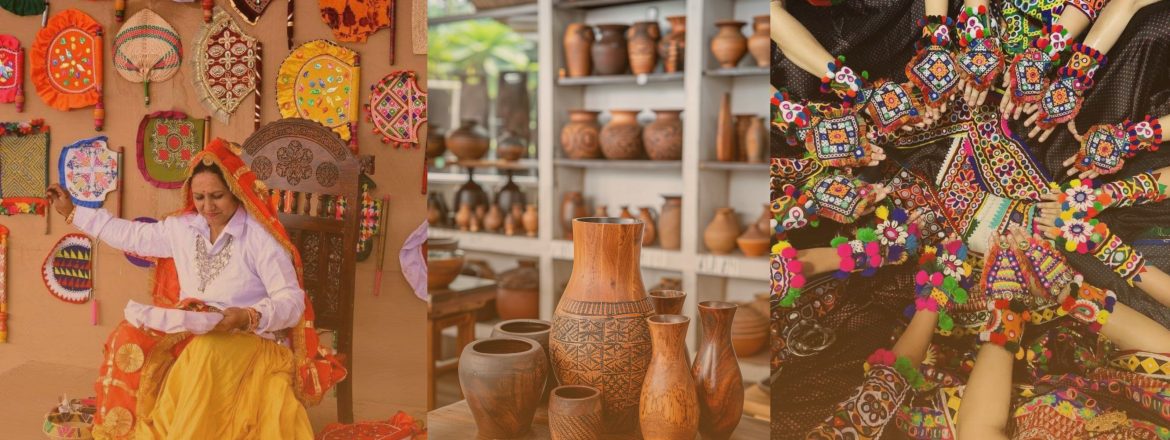How to Source Home Decor & Handicraft Products from India
Introduction
India has an enormous scope for the sourcing of home décor and handicraft products because of its sophisticated artisan culture, innovative designs, and cost- cost-effectiveness. Nevertheless, it takes considerable skill, good judgment, and advanced planning to turn that potential into a reliable supply chain. In this article, we will describe how to source home décor and handicraft products online from India in a systematic, professional manner so that you understand how to choose suppliers, check quality, manage logistics, and limit risk.
1. Understand the Indian Handicraft Landscape
1.1. Regional specializations and clusters
India’s handicraft production varies regionally:
- Varanasi and Lucknow for brocade and zari work
- Moradabad for brass and metalware
- Saharanpur and Jhargram for wood
- Firozabad for glass
Understanding the work clusters will allow you to focus your search and plan your visits.
1.2. Types and materials
Know the materials used: ceramics, glass crafts items, wood, metals, textiles. Some artisans combine techniques. Knowing these allows you to describe your product requirements.
2. Define Your Product & Quality Specifications
2.1. Create a detailed product brief
List the dimensions, weight, finish, and packaging needed, and what tolerances can be accepted, and what grades of materials you accept.
2.2. Minimum order quantities (MOQs)
Know the MOQ range before sourcing; artisan units typically want smaller runs, while factories will want you to scale.
2.3. Samples & prototypes
Always start with samples of merchandise being handmade prototypes, log the issues, and iterate until you are satisfied.
3. Identify Trusted Supplier Channels

3.1. Trade fairs and exhibitions
Events like India International Trade Fair, Ambiente India, and CII Handloom & handicrafts shows offer a live route to meet makers.
3.2. Government and export promotion bodies
Exhibitors such as the India International Trade Fair, Ambiente India, and the CII Handloom & handicrafts exhibitions provide an experiential connection to the makers.
3.3. B2B online marketplaces
Organizations such as the Handicrafts & Carpet Export Promotion Council (HAPPC), state handloom & handicraft boards, and export promotion councils have verified databases of artisans and exporters.
3.4. Sourcing agents and buying offices
Furthermore, working with a local sourcing agent minimizes the chance for miscommunication, assists with logistical concerns local to the sourcing location, and provides accountability for the work being completed, especially in remote sourcing clusters.
4. Supplier Shortlisting & Verification
4.1. Check credentials
It is important to request GST registration with a GST number, export registration (IEC), PAN#, physical sit,e or banking details. In addition to completing the background or down assessment on potential business partners, you should also verify that the exporter is a legitimate business by checking the legitimacy of the exporter with the local Organised Chambers of Commerce.
4.2. References and portfolios
Request client references, historical past export orders, and photo or video confirmation from the factory/facility or artisan workshop meeting export orders.
4.3. Factory or workshop visit
If possible, visit the facility to conduct your own evaluation for capacity, working conditions, equipment, and labor practices.
4.4. Audit for compliance
And a final due diligence check for compliance if the applicable with legal environmental standards, ethical labor practices, and adherence to quality standards if applicable; e.g., ISO, BSCI, SA8000, or quality assurance or labels, etc.
5. Ordering, Payment & Risk Mitigation
5.1. Terms and contracts
Prepare clear contracts governing specifications, delivery times, penalties for non-performance, and dispute settlement.
5.2. Payment structure
Common payment structure: 30% deposit; 70% on shipment or after the inspection process. If you anticipate a larger order, consider using an escrow account or the letter of credit (LC) process.
5.3. Quality control and inspections
Engaging a third-party inspection agency (e.g., SGS, Intertek) during the pre-shipment phase and having specifications rejected or rework asked, prior to shipping.
5.4. Insurance
Arrange for marine insurance and inland transit insurance to cover your goods while they are being transported inland and during sea/air freight.
6. Logistics & Shipping
6.1. Mode of transport
Choose between air freight (faster but expensive) and sea freight (cheaper but slower) to move your goods. If your order is a sample order or a small shipment, a courier service (e.g., DHL, FedEx) will deliver your goods quickly.
6.2. Packaging considerations
Export-grade packaging, good, strong cartons, cushioning material for fragile items, wooden crates or other crates for fragile items, especially for glass goods, and even wooden handicraft items.
6.3. Freight forwarding & customs
Have freight forwarders who know the Indian export process carry out and/or manage documentation (commercial invoice, packing list, certificate of origin, export license), handling, and customs clearance, etc.
6.4. Lead time buffer
Assume all will be delayed at the port or due to customs processes, and add in buffer time.
7. Branding, Customization & Intellectual Property
7.1. Private labeling & customization
Request artisans to add embossed logos, tags, or alternative finishes to further differentiate your assortment.
7.2. Design protection
For original designs, include design patents or trademarks in your plans. Designate NDAs and keep a record of all design transfers.
7.3. Cultural sensitivity
Be respectful of where artisans have their traditions and avoid designs that infringe on their customs and their local cultural motifs or religious iconography.
8. Scaling & Diversification
8.1. Expand supplier base
Avoid relying on a single supplier or cluster of suppliers. As the sales curve increases, diversify your association with suppliers across states and crafts.
8.2. Product line expansion
Once your home décor product line is established, begin considering semi-related products to add, such as textile crafts, metalware items, or decorative lighting items.
8.3. Leverage e-commerce
Use your supply chain to sell handicraft items Online directly on Etsy or Amazon Handmade, which helps volume, reach, and strengthen your brand.
9. Challenges & Common Pitfalls (and Solutions)
Challenge | Risk | Mitigation |
Quality inconsistency | Customer complaints | Strict sampling, QC, site inspections |
Communication gap | Misunderstood specs | Use clear visual references & prototypes |
Delay in delivery | Missed sales cycle | Buffer time, multiple suppliers |
Hidden costs | Erosion of margins | Detailed costing, including duties & packaging |
Cultural misunderstandings | Offended artisans | Show respect, offer fair pricing |
10.1. Fair wages & social impact
It is essential that artisans receive fair pay and that working conditions are safe. If appropriate, seek out certification such as Fair Trade.
10.2. Eco-friendly materials
Source sustainable materials, such as recycled glass, reclaimed wood, and natural dyes, and ask suppliers to provide you with eco-certification.
10.3. Community engagement
Engage artisan communities in training, build the capacity of artisans to improve their skill set, or have some social initiatives that focus on supporting the communities of artisans, to invest in your supply chain and brand narrative.
Conclusion & Call to Action
Ultimately, resiliency sourcing home décor and handicraft products from India takes time and patience, but when the process is considered, it is fulfilling. The journey of sourcing items requires both planning and diligence to focus on due diligence, ethical approaches, and having the discipline of operating procedures.
Sourcing can always begin with an order for samples, then begin to slowly but surely work to instill trust with suppliers, so that as time goes on and you build upon each other, you will be in a position to build long-term sourcing relationships. Good sourcing, if done well, is a way to deliver a product and brand experience to consumers or communities while supporting artisan communities sustainably.
Frequently Asked Questions (FAQ)
Sourcing services companies are professional firms that assist businesses with supplier relationship management, with an emphasis on efficiency and compliance, enjoying a long-term relationship and collaboration.
Agents usually manage single transactions, whereas sourcing companies create a working relationship with suppliers by employing a complete supplier relationship management process with strategic oversight.
Because trust and compliance help assure quality, minimize risk, and ensure delivery performance.
Technology provides transparency, risk monitoring, and automates and enables collaboration between buyers and suppliers across borders.
Sourcing services firms help mediate disputes, enforce contractual obligations and formalize a corrective actions plan, whilst assuring business continuity.
No. Small and medium-sized enterprises will also leverage the knowledge of sourcing services companies and access to their network to connect to global suppliers without excess overhead.









